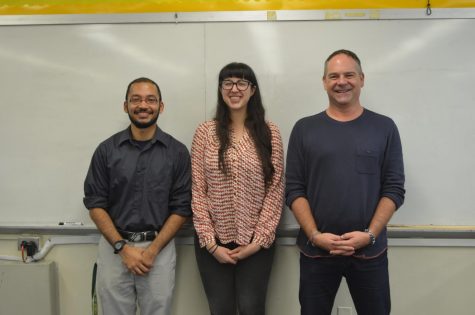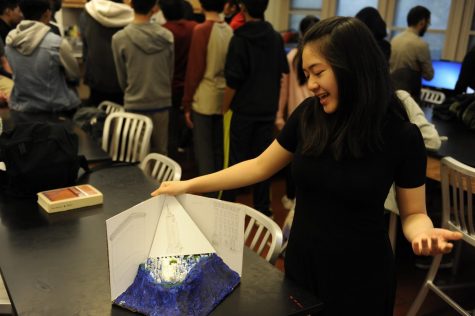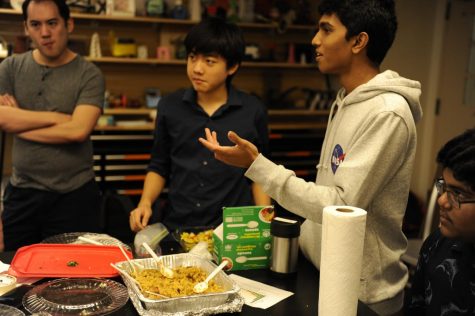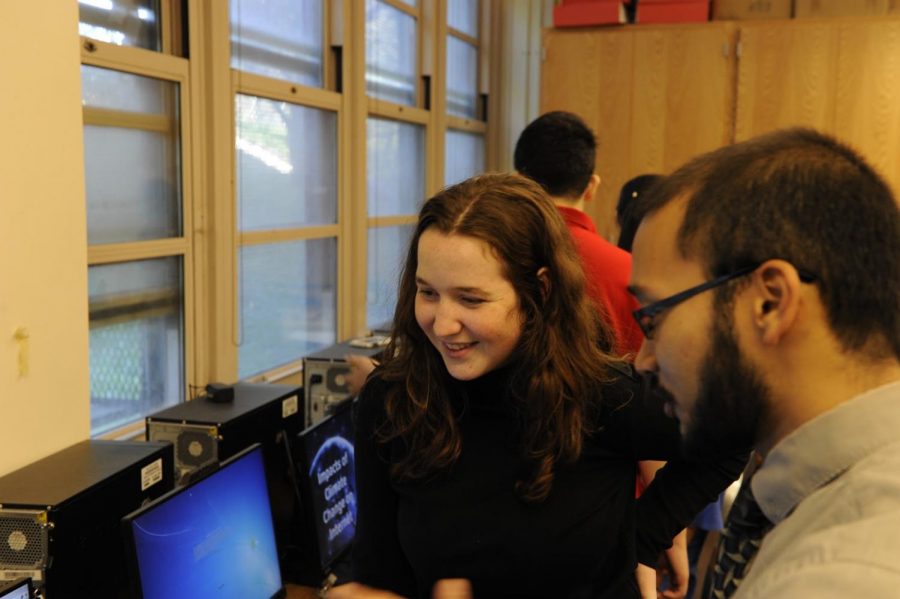Two Physics Teachers Lead Climate Awareness
Mr. Sarker and Sarah Mack ’19 discuss the results of a climate change survey that was given out to a freshman engineering class.
“100-year storm,” “500-year rainfall,” and “1,000-year flood.” These are descriptions of recent disasters that pop up on news headlines regularly now. From Hurricane Florence in North Carolina to Typhoon Mangkhut in the Philippines, deadly storms that have historically occurred once every century are now ravaging different parts of the globe annually. Climate science becomes more relevant by each waking storm.
The Bronx Science 2018-19 course offerings reflect this new age of climate awakening. A new engineering class called “Green Design and Clean Technology” tackles climate change and sustainability. Behind the innovative class are two individuals’ passions for physics and clean energy: Mr. Matthew Sarker, an engineering and physics teacher, and Ms. Rachel Wax, a physics teacher.

Mr. Sarker, Ms. Wax, and Mr. Wren pose for a photo during their Green Team meeting.
Mr. Sarker was first presented with the idea last year during a teacher’s workshop hosted by the NYC DOE Office of Sustainability. After sharing the proposal in a Bronx Science meeting, Ms. Wax joined the effort, and the pair worked hard to make a sustainability class become reality. Mr. Sarker shared that he draws inspiration for his course from David McKay’s TED talk and book. “He was using the tools of physics to improve the climate change conversation, and I felt like there was such a desperate need for that,” Mr. Sarker said. “The need for numbers informed by physics, the interdisciplinary nature of climate change, and learning about amazing technologies really hooked me.”
Ms.Wax is experienced in mechanical engineering with an emphasis on solar energy and fuel cells, and worked in green technology before she began teaching. When the idea of a green design class was presented to her last year, she immediately began planning. “Mr. Sarker and I have attended many workshops and taken classes about climate education. It is a newer field, so it is very exciting to be part of it at the ground level,” Ms. Wax said. “I think everyone needs to be environmentally literate and have a sense of responsible citizenship.”
They structured the course to be an open-ended, project-based class that would deviate from standard lecture-type instruction, and instead encourage self-guided discovery. By getting students involved in designing their future, Ms. Wax hoped the class would inspire students to become agents of change. “People have power to make change when they are educated and use their voice in an effective way,” Ms. Wax said. Similarly, Mr. Sarker is optimistic about what students will get out of the class. “I want the work we do here to matter – for us, our school, the city, and the world,” he said.

Alysa Chen ’19 presents her group’s 3-dimensional model that shows which parts of southern Manhattan will be underwater by 2100 due to sea level rise.
Given a variety of materials, green design students were presented with simple guidelines for their first project: show why climate change is an issue and offer feasible solutions. Taking advantage of the task’s open-endedness, projects ranged from food and art demonstrations to research and political maps. Sarah Mack ’19 and her group developed a survey to compare how opinions about climate change vary at Bronx Science. “A common occurrence is that people recognize that global warming is happening, but are unaware of how they can help as an individual,” Mack said. Her group hopes the survey sparks a discussion on what could possibly be added to our school curriculum.
“People have power to make change when they are educated and use their voice in an effective way.”
Another group proposed a composting program in order to reduce waste in homes and schools. “By introducing trash cans specifically for organic waste in the cafeteria, we can cut down on our landfill contribution,” Savino Barile ’19 said. “There exist large composting tumblers that are perfect for medium-scale composting programs like our school’s,” Eytan Stanton ’19 said. “If the school purchased this composting equipment, the gardening club could compost some of our own school’s waste and end up using it in our school’s garden.”

Ethan Ha ’19 and Raghav Inder ’19 present their sustainable food presentation. A homemade curry cauliflower-based dish is shown on the table.
As someone who loves to cook, Ethan Ha ’19 wanted to use this project to discuss how eco-friendly food choices do not have to be expensive or time-consuming as many people assume they are. “Restaurants may provide amazing dishes, but they pay little to no attention to food waste or carbon emissions caused by the foods they prepare for guests,” Ha said. During their food demonstration, they gave out samples of Mediterranean chicken sandwiches, which has less environmental impact than beef and pork, and a curry cauliflower dish, which was a tasty vegan dish that was also less expensive than beef. “Our goal was not to get them to abandon those foods, but to consume them less or adopt alternatives like poultry,” Raghav Inder ’19 said.
Johanna Neggie ’19 and her group felt that visuals would help illuminate the urgency of rising sea levels and what we can do to reduce global warming. “Our project is a visual representation of what our city could look like in another eighty years. By 2100, sea levels in lower Manhattan are expected to rise six to eight feet,” Neggie said. “I genuinely believe it is in our nature to not just roll over and give up when we see a problem right in front of us.”
These were some of the many projects done by green design students. This first project alone paves the way for Bronx Science’s future involvement in mitigating climate change. This opportunity would be impossible without the dedication of Mr. Sarker and Ms. Wax. They deserve a round of applause for their astounding leadership in leading the effort to address one of the most critical issues of this century.
For information about the school’s new Green Team, email Mr. Sarker at [email protected], Ms. Wax at [email protected], and/or Mr. Wren at [email protected].
Alysa Chen is an Editor-in-Chief for ‘The Science Survey’ and an Academics Section Reporter for ‘The Observatory.’ She enjoys journalistic writing...
Pietro Topa is the Editorial Editor for ‘The Science Survey’ as well as a Groups Section Reporter for The Bronx High School of Science yearbook, ‘The...
Tobias Dohlin is the Cartoonist for ‘The Science Survey’ and is a Group Section Staff Reporter for ‘The Observatory.’ Art and Politics have always...











